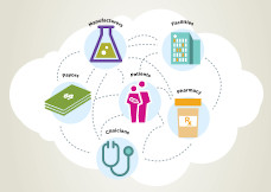Sheldon Moberg, VP of Device Technologies at Amgen, shared an interesting statistic at last years’ Parenteral Drug Association meeting: 120 days after hospital discharge, 17% of myocardial infarction patients had not filled their heart medication prescriptions and an astounding 65% had not filled their co-morbidity prescriptions.[1]
It is stunning to think that a person who has gone through an event as significant as a heart attack could so quickly forget to take a life-saving medication. Even though the drug has proven health benefits, if the patient can’t tell it is doing something, he or she might be inclined to think that it is not needed. This problem is commonly labeled non-adherence. Though the factors causing this dysfunction are becoming clearer, the solutions to drive adherence are less so.
Historically, drug companies tended to believe that if you design a drug that is effective and safe, then sophisticated marketing is all you need to ensure awareness, adoption, and blockbuster sales. Drug companies must get beyond traditional efficacy and safety metrics, and find ways to connect to patients so that they not only buy their medications, but also regularly take them.
Meaningfully connecting with consumers is not a new approach. Non-medical companies have long understood that you have to authentically and meaningfully connect with consumers at an emotional level. As described in Fiske and Silverstein’s groundbreaking book Trading Up, BMW is one of several companies who have been able to elevate their brand and grow a disproportionate share of loyal customers. BMW has achieved this by flawlessly executing technical, functional, and emotional factors that resonate with their target customers. These three elements are built progressively, one atop of the other.
To create a technical foundation, BMW has established its brand on the performance of their engines, as well as the drivability and unique aesthetic of their vehicles. Regardless of model, their engines are powerful, smooth, and reliable. Equally importantly, BMW has leveraged their suspension know-how and racing prowess to create vehicles that are remarkable to drive around town, and on the track. And BMW has consistently designed vehicles that are fresh, timeless, and remarkable.
At the second level, BMW has worked on is vehicle functionality. Aspects such as driver ergonomics, as well as precise steering and linear braking, help to connect the driver to the vehicle in ways that other cars fall short. Similar detail has been paid to opening and closing doors, fastening seat belts, and manipulating switch-sets. These items combined help to stimulate and satiate drivers and passengers alike.
The third level, known as emotional factors, is achieved through BMW’s synergistic interplay between functional and technical aspects of the vehicle. As outlined by Silverstein and Fiske, these emotions can be grouped into four areas: taking care of me, connecting, questing, and individual style Drivers and passengers are drawn to BMWs because they provide a form of emotional nourishment.
Cars take care of consumers, offering them flexible and safe transportation—95% of American households own one. Consumers’ connection with the brand are driven by well-executed marketing. One can splurge on a 3-series or 5-series and justify the purchase because driving it is a form of renewal or reward. Driving a BMW can help its owners to attract others and its high-performance capability can help one to fulfill a desire to quest and seek adventure. Finally, a BMW enables its drivers and occupants to signal to others that you have “made it”, thereby helping to elevate one’s personal brand.
What can drug companies learn from BMW? That they need to create experiences that consumers need and crave. As we have learned, drug effectiveness alone does not ensure adherence. From a technical perspective, pharmaceutical companies must create devices that consistently and reliably deliver the right dose volume to the right target location. From a functional perspective, devices must comfortably fit the body, be easy to manipulate and provide good feedback during dose delivery and dose completion. From an emotional perspective, delivery systems should, at a minimum, reduce user anxiety and provide a sense of independence. Arguably, pharmaceutical companies have a significant opportunity to further expand their emotional connections with their customers. Consumption and management of medication could be socialized in such a way that patients feel connected to others, and their loved ones and friends feel empowered to help them continue to take life-saving medications. The emotional benefit of self-nurture can help one to develop better, healthier routines that may help to reduce one’s reliance on medication. And there are other possible emotional benefits that could be extended into the pharmaceutical industry, such as attracting and self-branding. How these could be realized to improve adherence are less obvious, but potentially even more profound.
—
[1] “Prevalence, Predictors, and Outcomes of Primary Nonadherence After Acute Myocardial Infarction,” Circulation, 2008;117:1028-1036



